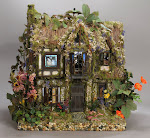Just what is a Faery Dollhouse?
Fairy or Faery Dollhouses are a recent evolution of the traditional dollhouse which come in two basic styles:
- the Fairy House is a not-to-scale natural dwelling of any size as might be made by fairies generally using natural materials (hollowed tree stumps, rocks, twigs, mosses,nuts, etc. and may be an indoor decorative item or an outdoor creation made to attract fairies to one's garden. May also be a Toad House. These are produced both by gifted artisans and by children and have a range of supportive literature.
- the actual Fairy Dollhouse is built to human scale, usually 1:12 inch and uses the conventions of a traditional dollhouse. These houses may utilize existing dollhouses (conversions), dollhouse kits (bashing) or may be entirely designed and executed by the artist.
 4-6" beings) landscaping and materials should be in 1:1 life scale. For the purist this presents the issue of weather Fairy Houses are miniatures at all or simply life-sized small buildings existing in a large world? But for those of us create and collect fairy houses, we simply do not care. The combination of scale just adds to the enchantment for anyone who ever wished a dollhouse was "real".
4-6" beings) landscaping and materials should be in 1:1 life scale. For the purist this presents the issue of weather Fairy Houses are miniatures at all or simply life-sized small buildings existing in a large world? But for those of us create and collect fairy houses, we simply do not care. The combination of scale just adds to the enchantment for anyone who ever wished a dollhouse was "real". While the popularity of this genre is recent and increasing, its roots go back to a few traditional dollhouse builders who created magical fairy dollhouses. Anne Gerdes' famous and award winning Mossy Manor created in 1996 for the Seattle Dollhouse and Miniature Show is a tremendous inspiration to the fantasy dollhouse artists who began by searching the Web for ideas. This site is a must see for both collectors and artists. You will see many of the elements of today's craftsmen including the tudor half timbered structure, thatch roof, moss, use of rocks, twigs, acorns etc. The ivy on the roof is indicative of the first steps into using dual scale construction. I know my own work owes her a tremendous debt of gratitude. Her web page continues to inspire budding fairy craftsmen. http://anniesminis.com/mossy.htm
The aftermath of the enormous popularity of hobby dollhouse kit building in the 1980's and 1990's resulted in a plethora of abandoned dollhouses (frequently painted hot pink or lavender) showing up in garage sales and thrift shops. As the enthusiastic hobbiest moved onto scrapbooking and hobby stores no longer carried enticing miniature furniture and supplies, the construction of dollhouses returned to the world of the dedicated artisan.
The similtaneous growth in popularity of the Fantasy genre in film and books led to a wonderful opportunity of recycling abandoned thrift store dollhouses into Fairy Houses. With the resources available on the internet the owner of a shabby craft dollhouse found at a yard sale could convert the structure into a updated fairy house for herself or her daughter for a fraction of the cost of building and outfitting a traditional dollhouse. A trip into the woods or to a city park could yield a weath of supplies-acorns, twigs, a stray bird feather, and shells. Leftover beads and broken jewelry became jeweled embellishments and fairy treasure troves. One of my greatest "finders" is my young niece, Grace, who is ever on the look-out for fairy artifacts for me! There are few "greener" buildings than a fairy dollhouse.
